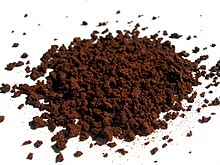Agglomeration (process engineering)
Agglomeration [lat.] Means to accumulate, in process engineering the enlargement of a particle . One also speaks of grain enlargement or making lumpy . It is one of the four main process groups in mechanical process engineering and describes the shift in the particle size distribution (grains, droplets , gas bubbles) into a coarser size range. The fine material is created by interfacial forces that agglomerate it into pieces of irregular shape and size.
Agglomeration is usually not an intended process.
It can only be brought about by reducing the particle size.
- When build-up granulation, also known as pelletizing, produced granules . The interfacial forces are hardened binders , capillary forces , molecular attraction and interlocking bonds on a jagged or fibrous surface. The granulation can be done wet or dry. A distinction is made between fluidized bed granulation, mixed agglomeration and rewetting agglomeration.
- Sintering is a process in which fine-grained, solid substances are heated to such an extent that the molecules on the melting particle surfaces can form bonds with one another.
- By molding - even press agglomeration - produced flakes , tablets, pellets or briquettes
- By flocculation , it is achieved that solid particles in liquids unite to form larger particles, and thereby more easily filtered out may be used.
literature
- Heinrich Schubert : Manual of mechanical process engineering . Weinheim 2003
- Werner Hemming: Process engineering . Wuerzburg 1991
- Gerald Heinze: Handbook of agglomeration technology . Weinheim 2000
